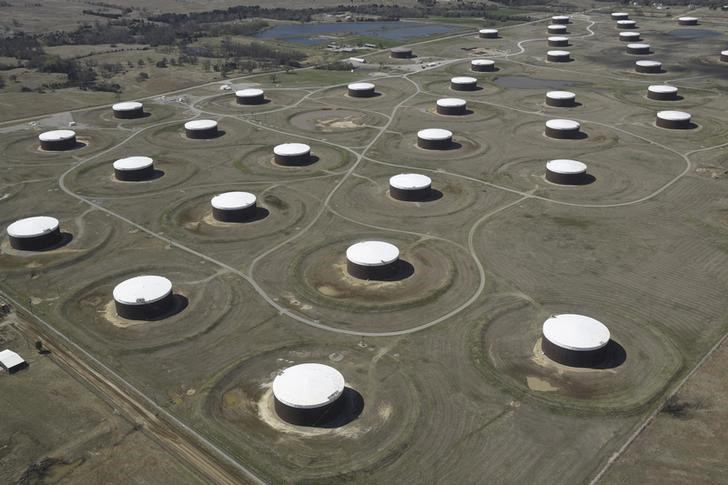 © Reuters. Crude oil storage tanks are seen from above at the Cushing oil hub in Cushing
© Reuters. Crude oil storage tanks are seen from above at the Cushing oil hub in CushingBy Libby George
LONDON (Reuters) – Oil prices weakened following early gains on Wednesday, but remained underpinned by tightening supply and strong global demand.
Tighter fundamentals have lifted both crude futures benchmarks about 13 percent above levels in early December, helped by production curbs by OPEC and Russia, as well as by healthy demand growth.
Brent crude futures () were at $69.94 a barrel at 0946 GMT, down 21 cents from the last close, after hitting $69.37. Brent on Monday rose to $70.37 a barrel, its highest since December 2014.
U.S. West Texas Intermediate (WTI) crude futures () were at $63.60 a barrel, down 13 cents on the day and down from $63.89 earlier. WTI hit $64.89 on Tuesday, also the highest since December 2014.
“Currently there is no reason to believe that there has been a significant change in the underlying fundamental sentiment and the sell-off is, so far, viewed as a technical correction,” said Tamas Varga, analyst with PVM Oil Associates in London.
The Organization of the Petroleum Exporting Countries and Russia have been curbing production since January last year and the cuts are set to last through 2018.
The curbs have coincided with healthy demand and solid economic growth, and as a result the market has tightened, helping to push prices up more than 50 percent from June 2017.
But markets may come under pressure from rising U.S. production, analysts say.
On Tuesday, the U.S. Energy Information Administration said it expected the country’s oil output to rise in February, with production from shale rising by 111,000 barrels per day (bpd) to 6.55 million bpd.
U.S. crude output
Norbert Ruecker, head of commodity research at Swiss bank Julius Baer, also said that “hedge fund expectations for further rising prices have reached excessive levels,” threatening prices.
Money managers have raised the bullish positions in WTI and Brent crude futures and options to a record, according to data from the U.S. Commodity Futures Trading Commission and the Intercontinental Exchange.
BMI Research said seasonally high refining run rates from the northern hemisphere winter season were set to fall substantially as the end of winter approaches.
Brent spot crude futures contracts have already moved out of winter, now trading for March delivery.
“This will act as a substantial drag on global crude demand in Q1 and feeds into our bearish short-term outlook on Brent,” BMI said.
Fusion Media or anyone involved with Fusion Media will not accept any liability for loss or damage as a result of reliance on the information including data, quotes, charts and buy/sell signals contained within this website. Please be fully informed regarding the risks and costs associated with trading the financial markets, it is one of the riskiest investment forms possible.
Source: Investing.com




























